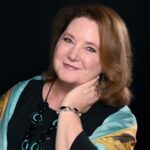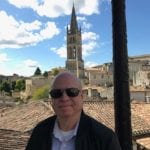Cuba: Cienfuegos & Santiago de Cuba
Havana, Cuba’s largest city, has 2 million inhabitants, while Cienfuegos has about 100,000. It’s considered by Cubans we met the most beautiful city in Cuba in which they’d like to live or retire to, and is known as the “Pearl of the South.”
Cienfuegos was first settled by Taino Indians, who came from South America and settled here, as well as in Puerto Rico and Jamaica. They disappeared after the Spanish moved in.
Our fathom itinerary included a half-day here. Onboard Adonia, our fathom cruise ship, a staffer shares his encounter with a local here who was walking down the street with a bird in a cage. When asked why he was doing so, he replied he was taking his bird for a walk. “Even if you are in a cage, your mind and body can be free, ” he added…
At the Museum of Cuban Art, I recalled, there hangs a sculpture of a cage, with a human doll inside. The cage door is open and the figure inside is smiling.
At the home of Jorge, an artist, we’re intrigued by his paintings of golfers. In one painting, the golf ball is sitting on the edge of the plane, a precipice below. The golfer is getting ready to make his shot, but the shot is difficult because the ball is on the edge of the plane. In another, there is a green golf field with two golf holes. In one stands a Cuban revolutionary, both feet in the hole.
Jorge explained that you know there is another hole which can be seen, but you’re stuck in your hole and don’t know how to get to the other one. These are impressions that convey a lot about Cuba and how Cubans may feel.
As we disembarked the ship in Cienfuegos, Immigration took our temperatures on our foreheads; anyone with a high temperature is allowed in. We boarded air conditioned coaches and drove into downtown and walked the main square. Shops were opening up, and everywhere you turn you can take in local life.
A birthday was being celebrated nearby, a street vendor was selling fruits. We ended up in the beautiful Theatre Tomas Terry, built by French and Italian architects, and where we enjoyed a wonderful 40-minute choir performance.
Walking into a gallery off the main square, the owner made sure I understood he accepted US Visa credit cards — another surprise.
As in Havana, we saw workers refurbishing old buildings. While work appears to proceed at a slow pace, it’s not surprising in the heat of August and high humidity.
Driving to the southern tip of Punta Gorda, we drive by single family homes, as well as neoclassical French-built mansions.
In that final port of call, people seemed more assertive than in Havana. There were the elderly, asking for handouts, and merchants tried to engage you more, too. We also found it more prevalent local merchants were willing to take USD or Euros as payment.
On two occasions, and without asking, I was given change back in USD when paying with CUCs.
Santiago de Cuba is wrapped up in history — and Fidel’s grave is reputedly being readied in the cemetery here, just below that of Marti.
Here is San Juan Hill, made famous when Teddy Roosevelt and his Rough Riders, fighting with Cubans, took control of it from the Spaniards. Castillo de San Pedro, a UNESCO World Heritage site, is an impressive 17th century castle. There are the Moncada Barracks that were first attacked by Castro when he was 26, and failed. The bullet holes have been recreated in the walls (as the original ones were covered up).
Here is one of Cuba’s larger monuments, a statue of Marti, Cuba’s national hero, as well as his tomb, protected and watched over by armed guards, at Santa Ifigenia Cemetery. Rumors, visually backed by workers on the site, are that Fidel Castro’s tomb is being prepared adjacent to Marti’s.
Beyond all its history, Santiago de Cuba is lovely with much activity, and some beautifully restored buildings.
Traveling on multiple coaches throughout the city doesn’t make us inconspicuous, especially as we had a police escort that stopped traffic — even a train — to let us through.
Fathom groups passengers into about 20 – 25 groups of about 30 persons, each on its own motor coach. Our “people to people” activities varied depending on which coach you were on. Ours included having a q&a with the owner and staff of the paladars where we had lunch, and attending an all women music group — the only one in this region — that performed Cuban music for us and even included us in a sing a long.
We left Cuba elated in finally visiting a country that’s been off-limits far too long, witnessing how our visit is part of a dramatic change occurring here, and hopeful that this change brings far more positive results to a mostly impoverished country whose people are warm and gracious.
For those planning to visit, the biggest challenge is booking way ahead, securing hotel accommodations and, depending on the level of service desired, working with better established companies that can help “guarantee” your reservations.
Demand to visit Cuba far outweighs those available hotel rooms that US travelers will generally find acceptable — especially at the premium Americans pay to travel here. For those willing to pay the premium, however, there are good options available.
Let our travel experts, including Dan Ilves, help you plan a Cuba vacation.




